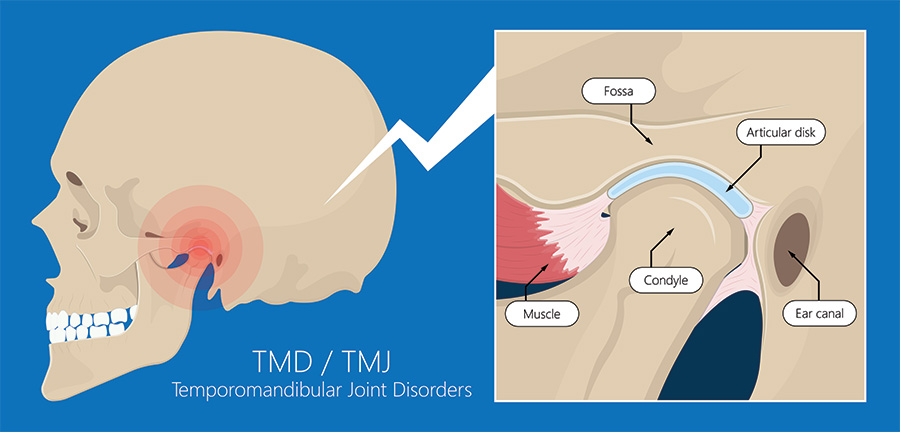What Are the Benefits of Treatment for TMJ Disorder?
Treatment for TMD can reduce symptoms, which often include:
- Pain while trying to open the mouth or while chewing food
- Tension near the neck and shoulders
- Clicking or popping sounds that occur when you open your mouth
- A sudden, uncomfortable bite position
- Swelling on your face
- A jaw that becomes stuck in a specific position
- Frequent headaches or toothaches
- Dizziness or ringing in the ears
Am I a Candidate for TMD Treatment?
If you experience jaw-clicking or unexplained head, neck, or shoulder pain, you may benefit from treatment and should undergo an assessment.

What Techniques Are Used to Treat TMD?
During your consultation with Dr. Kohani, he will perform a dental exam, obtain images with a 3D digital CT scanner, and discuss the symptoms you are experiencing. He will also examine your jaw to listen for any pain or popping sounds and your muscles to see if they are working correctly.
The goal is to rule out other underlying conditions that could be causing the problem, and if Dr. Kohani diagnoses you with TMJ disorder, he can begin treatment. Depending on the specific cause, he will recommend the following treatments:
- Bruxism – If tooth grinding has caused the problem, a nightguard can prevent the consequences of this often unconscious habit.
- Mishapen or small teeth – If bruxism has led to worn-down teeth and problems with your bite, Dr. Kohani may advise you to have crowns placed to restore your teeth to their original shape.
- Orthodontic issues – Crooked, crowded, and misaligned teeth can also interfere with your bite, in which case, braces or clear aligners like Invisalign® can help.
- Missing teeth – If a gap in your smile is to blame for your TMJ disorder, an implant or dental bridge may help solve the problem.
- Strained muscles – When overuse or stress has caused repeated muscle contractions, BOTOX® can be an excellent solution.
In rare cases of severe TMD, surgery may be needed to correct the issue.
Can TMD Be Treated With BOTOX®?
In treating TMD, the intent is to retrain the jaw muscles to become properly aligned when in use and at rest. BOTOX® injections are a temporary muscle relaxant used to alleviate jaw tension and keep the muscles from contracting.
BOTOX® is typically injected into the temporalis, frontal, and masseter muscles to improve the symptoms associated with TMJ disorder. This treatment usually takes no more than 30 minutes to receive, will last for roughly six months, and can be performed right in Dr. Kohani’s office.
Combining BOTOX® with other corrective measures can deliver ideal results in patients with complex TMD. BOTOX® injections do not affect surrounding muscles that are not contributing to this condition.
Is There Downtime Associated With Treatment for TMJ Disorder?
Depending on the type of treatment needed to correct your TMD, there may be no recovery period involved at all.
- Nightguards and clear aligners are not associated with any downtime.
- BOTOX® injections may lead to temporary redness, and you may be instructed to stay upright for a few hours.
- Restorations like crowns or bridges may result in some soreness lasting up to 24 hours.
- Dental implants require oral surgery and some downtime. Several factors will determine the length of your recovery.
- Other surgical procedures will also include downtime.
What Results Can I Expect After TMD Treatment?
It may take some time for final results, including complete pain relief, to be achieved. Nightguards and restorations can provide relief within weeks to months, and orthodontic treatments or dental implants often take up to a year. BOTOX® injections tend to offer the fastest results.
How Can I Contact a San Diego, CA, TMJ Expert?
If you think you have TMD, contact La Jolla Cosmetic Dentistry & Orthodontics by calling 858-295-0603 to schedule a comprehensive consultation and examination with Dr. Kohani.
 Most people take a healthy jaw for granted until problems arise. TMJ is an acronym for the temporomandibular joint, which connects your upper and lower jaw to your skull at the front of your ears. A healthy temporomandibular joint allows you to open your mouth comfortably to talk, chew, yawn, laugh, or move your jaw up or down and side to side. TMJ is often associated with a type of temporomandibular disorder, or TMD, which is frequently misdiagnosed because its symptoms can be related to other conditions, such as migraines or certain dental issues. However, if TMD is diagnosed, treatment is available to help relieve your pain.
Most people take a healthy jaw for granted until problems arise. TMJ is an acronym for the temporomandibular joint, which connects your upper and lower jaw to your skull at the front of your ears. A healthy temporomandibular joint allows you to open your mouth comfortably to talk, chew, yawn, laugh, or move your jaw up or down and side to side. TMJ is often associated with a type of temporomandibular disorder, or TMD, which is frequently misdiagnosed because its symptoms can be related to other conditions, such as migraines or certain dental issues. However, if TMD is diagnosed, treatment is available to help relieve your pain.



